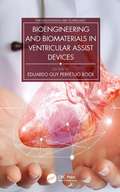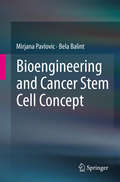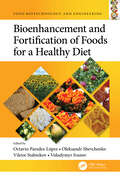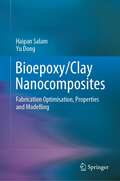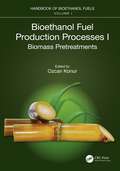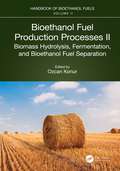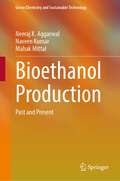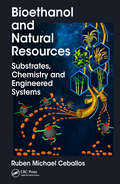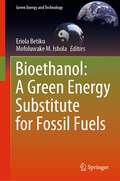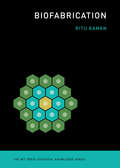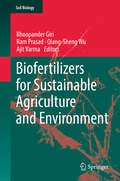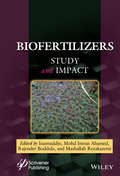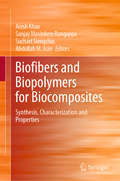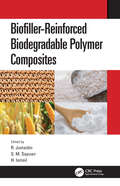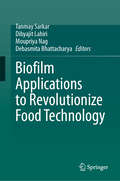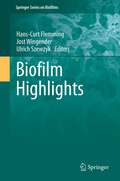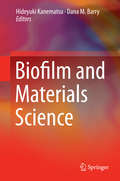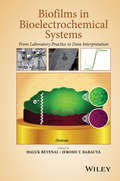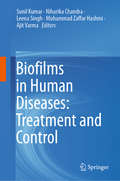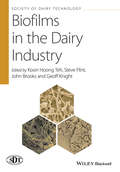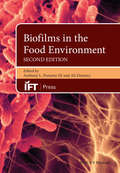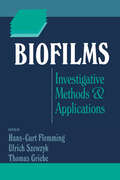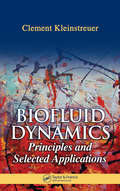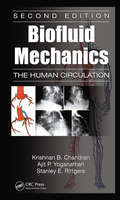- Table View
- List View
Bioengineering and Biomaterials in Ventricular Assist Devices (Emerging Materials and Technologies)
by Eduardo Guy Perpétuo BockOften associated with artificial hearts, ventricular assist devices (VADs) are blood pumps that can provide circulatory assistance to the left ventricle, the right ventricle, or both. Bioengineering and Biomaterials in Ventricular Assist Devices reviews constructive details of VADs and the biomaterials used in their development and support. FEATURES Establishes an area of intersection between engineering and medicine Shows process development from mechanical design to automation and control Discusses biofunctional materials, tribology in ceramic biomaterials, biosensors, and surface engineering and blood This text is aimed at advanced students, researchers, and practicing engineers conducting work on VADs and will be of interest to a broad interdisciplinary group, including bioengineers, materials engineers, chemical engineers, mechanical engineers, and electrical engineers.
Bioengineering and Biophysical Aspects of Electromagnetic Fields, Fourth Edition (Handbook of Biological Effects of Electromagnetic Fields)
by Frank Barnes Ben GreenebaumThe two volumes of this new edition of the Handbook cover the basic biological, medical, physical, and electrical engineering principles. They also include experimental results concerning how electric and magnetic fields affect biological systems—both as potential hazards to health and potential tools for medical treatment and scientific research. They also include material on the relationship between the science and the regulatory processes concerning human exposure to the fields. Like its predecessors, this edition is intended to be useful as a reference book but also for introducing the reader to bioelectromagnetics or some of its aspects. FEATURES • New topics include coverage of electromagnetic effects in the terahertz region, effects on plants, and explicitly applying feedback concepts to the analysis of biological electromagnetic effects • Expanded coverage of electromagnetic brain stimulation, characterization and modeling of epithelial wounds, and recent lab experiments on at all frequencies • Section on background for setting standards and precautionary principle • Discussion of recent epidemiological, laboratory, and theoretical results; including: WHO IARC syntheses of epidemiological results on both high and low frequency fields, IITRI lab study of cancer in mice exposed to cell phone-like radiation, and other RF studies • All chapters updated by internationally acknowledged experts in the field
Bioengineering and Cancer Stem Cell Concept (SpringerBriefs in Computer Science #0)
by Bela Balint Mirjana PavlovicThis book explores the role of cancer stem cells in the diagnosis, treatment, and cure of cancers. This book also tackles novel methodology for cancer stem cell marker identification, cancer stem cell respiration and metabolism, genetic and epigenetic mechanisms including DNA methylation, and mi-RNA assemble. It also emphasizes the role of Bioinformatics techniques, which provide a novel methodology for modeling cancer outcomes. The authors investigate the difference between cancer stem cells and normal stem cells, along with the concept of targeted cancer stem cell therapy. Although the theoretical explanations of cancer stem cell involvement in leukemia and solid cancers are controversial, there is now little doubt that cancer stem cells exist within otherwise heterogeneous cancer cell population. The brief examines the two leading theories, hierarchical and the stochastic/cancer stem cell model. Researchers, professors and advanced-level students focused on bioengineering and computer science will find this book to be a valuable resource. It is a very good source of critical references for understanding of this problem, and a useful tool for professionals in related fields.
Bioenhancement and Fortification of Foods for a Healthy Diet (Food Biotechnology and Engineering)
by Volodymyr Ivanov Viktor Stabnikov Octavio Paredes-López Oleksandr ShevchenkoBioenhancements of cereal and dairy compositions can play an important role in healthy diets. The latest addition to the new Food Biotechnology and Engineering series, Bioenhancement and Fortification of Foods for a Healthy Diet covers the technological and nutritional aspects of the compositions of cereals, dairy products, vegetables, and fruits. The book demonstrates real developments in food technology and reviews current knowledge in the biotechnological processing and bioenhancement of food. Key Features: Promotes the use of iron-containing nanoadditive in bakery and confectionary Explains the use of food additives for enrichment of butter mixtures Covers the use of artichoke powder and buckwheat bran in diabetic bakery products Describes the use of milk proteins in the technology of bakery products Proposes the use of spice compositions for sour milk products Organized in five parts, Bioenhancement and Fortification of Foods for a Healthy Diet addresses bakery and confectionery products, technologies for cereals enhancement, technologies for dairy products enhancement, food supplements, and finally, new technology processes. The book is an aide to food scientists and engineers contributing to the development of high-quality food products. Also available in the Food Biotechnology and Engineering series: Volatile Compounds Formation in Specialty Beverages, edited by Felipe Richter Reis and Caroline Mongruel Eleutério dos Santos (ISBN: 9780367631901) Native Crops in Latin America: Biochemical, Processing, and Nutraceutical Aspects, edited by Ritva Repo-Carrasco-Valencia and Mabel C. Tomás (ISBN: 9780367531409) For a complete list of books in this series, please visit our website at: https://www.routledge.com/Food-Biotechnology-and-Engineering/book-series/CRCFOOBIOENG
Bioepoxy/Clay Nanocomposites: Fabrication Optimisation, Properties and Modelling
by Yu Dong Haipan SalamThis book highlights current advanced developments in bioepoxy and bioepoxy/clay nanocomposites and an optimisation of material formulation and processing parameters on fabrication of bioepoxy/clay nanocomposites in order to achieve the highest mechanical properties in relation to their morphological structures, thermal properties, as well as biodegradability and water absorption, which is based on the use of Taguchi design of experiments with the consideration of technical and economical point of view. It also elaborates holistic theoretical modelling of tensile properties of such bionanocomposites with respect to the effect of contents of nanoclay fillers and epoxydised soybean oil (ESO).
Bioethanol Fuel Production Processes. I: Biomass Pretreatments
by Ozcan KonurThis book presents research on biomass pretreatments, which are a fundamental part of bioethanol fuel production to make biomass more accessible. This book also includes an introductory section on the bioethanol fuels. Bioethanol Fuel Production Processes. I: Biomass Pretreatments is the first volume in the Handbook of Bioethanol Fuels (Six-Volume Set). The primary pretreatments at the macro level are the biological chemical, hydrothermal, and mechanical pretreatments of the biomass. It also has an introductory section on the biomass pretreatments at large for bioethanol fuel production. The major pretreatments at the micro level are the enzymatic and fungal pretreatments of the biomass as the biological pretreatments, acid, alkaline, ionic liquid, and organic solvent pretreatment pretreatments of the biomass as the chemical pretreatments, steam explosion and liquid hot water pretreatments of the biomass as the hydrothermal pretreatments, and milling, ultrasonic, and microwave pretreatments of the biomass as the mechanical pretreatments. The first volume also indicates that a wide range of pretreatments stand alone or in combination with each other fractionate the biomass to its constituents of cellulose, lignin, and hemicellulose and improve both sugar and bioethanol fuel yield, making this bioethanol fuel more competitive in relation to crude oil- and natural gas-based fossil fuels. This first volume is a valuable resource for the stakeholders primarily in the research fields of energy and fuels, chemical engineering, environmental science and engineering, biotechnology, microbiology, chemistry, physics, mechanical engineering, agricultural sciences, food science and engineering, materials science, biochemistry, genetics, molecular biology, plant sciences, water resources, economics, business, management, transportation science and technology, ecology, public, environmental and occupational health, social sciences, toxicology, multidisciplinary sciences, and humanities among others.
Bioethanol Fuel Production Processes. II: Biomass Hydrolysis, Fermentation, and Bioethanol Fuel Separation
by Ozcan KonurThis book provides an overview of the research on production processes for bioethanol fuels in general, hydrolysis of the pretreated biomass for bioethanol production, microbial fermentation of hydrolysates and substrates with yeasts for bioethanol production, and separation and distillation of bioethanol fuels from the fermentation broth, complementing the research on biomass pretreatments presented in the first volume. It presents an overview of the research on biomass hydrolysis in general, wood hydrolysis, straw hydrolysis, and cellulose hydrolysis for bioethanol fuel production in the first section for biomass hydrolysis. It provides an overview of the research on microbial hydrolysate fermentation for bioethanol production in general, alternative fermentation processes for bioethanol fuel production such as simultaneous saccharification and fermentation (SSF) and consolidated biomass processing (CBP) compared with the separate hydrolysis and fermentation (SHF) process, metabolic engineering of microorganisms and substrates for bioethanol fuel production, and utilization of Saccharomyces cerevisiae for microbial fermentation of hydrolysates for bioethanol fuel production in the second section for hydrolysate fermentation. It provides an overview of the research on the bioethanol fuel separation from the fermentation broth in the last section. This book is a valuable resource for the stakeholders primarily in the research fields of energy and fuels, chemical engineering, environmental science and engineering, biotechnology, microbiology, chemistry, physics, mechanical engineering, agricultural sciences, food science and engineering, materials science, biochemistry, genetics, molecular biology, plant sciences, water resources, economics, business, management, transportations science and technology, ecology, public, environmental and occupational health, social sciences, toxicology, multidisciplinary sciences, and humanities among others.
Bioethanol Production: Past and Present (Green Chemistry and Sustainable Technology)
by Naveen Kumar Neeraj K. Aggarwal Mahak MittalThis book provides the latest research on bioethanol production from first- and second- generation feedstock. Bioethanol has emerged as one of the main alternative biofuels in recent years. The book provides a perspective on the chemistry, sources and production of bioethanol highlighting the recent developments in the field.Through this book readers will learn basic and advanced bioethanol production technologies under one roof, including resource management and environmental and economic impacts. The topics discussed in the book will attract researchers and scholars focusing in this field as well as anyone who is interested in green and sustainable energy resources.
Bioethanol and Natural Resources: Substrates, Chemistry and Engineered Systems
by Ruben Michael CeballosBioethanol and Natural Resources: Substrates, Chemistry and Engineered Systems provides a comprehensive review of feedstocks, physiochemical and biological pretreatments, molecular substrates, cellulolytic and ligninolytic enzymes, and advanced technologies for producing bioethanol. Although this book provides a review of first-generation bioethanol feedstocks, chemistry, and processes, there is an emphasis on second-generation "cellulosic" ethanol production. With rapid advances in biofuels technologies and the continued global dependency on unsustainable extraction of fossil fuels, this text is timely. Although it is intended to be used as a supplemental text for advanced undergraduate or graduate level courses, the book is accessible to a non-academic audience. This book provides a unique opportunity to understand bioethanol production from the basic concepts and processes to the most cutting-edge technologies under development.
Bioethanol: A Green Energy Substitute for Fossil Fuels (Green Energy and Technology)
by Eriola Betiku Mofoluwake M. IsholaThis book looks deeply into the prospects for using ethanol as a greener alternative to fossil fuels and the technical and scientific issues that surround them. Ethanol, with its numerous advantages, has emerged as a promising contender to replace gasoline as a fuel source. Currently, it is commercially available as a blend with gasoline, commonly known as E10 and E25, utilizing various ratios of ethanol. Despite its clear benefits over gasoline, the widespread adoption of ethanol as a fuel remains hindered by its limited availability. In this insightful book, we aim to explore the multifaceted challenges surrounding ethanol's full integration into our energy landscape, employing a comprehensive approach through review manuscripts. Leading worldwide experts, known for their deep understanding of ethanol as a fuel, have contributed to the book. Their valuable insights and contributions enrich the book's content, offering readers a comprehensive exploration of the subject matter. This book is a compelling resource for researchers, energy professionals, and anyone interested in understanding the challenges and opportunities associated with the integration of ethanol as a substitute for gasoline.
Biofabrication (The MIT Press Essential Knowledge series)
by Ritu RamanHow engineered materials and machines powered by living biological cells can tackle technological challenges in medicine, agriculture, and global security.You are a biological machine whose movement is powered by skeletal muscle, just as a car is a machine whose movement is powered by an engine. If you can be built from the bottom up with biological materials, other machines can be as well. This is the conceptual starting point for biofabrication, the act of building with living cells--building with biology in the same way we build with synthetic materials. In this volume in the MIT Press Essential Knowledge series, Ritu Raman offers an accessible introduction to biofabrication, arguing that it can address some of our greatest technological challenges. After presenting the background information needed to understand the emergence and evolution of biofabrication and describing the fundamental technology that enables building with biology, Raman takes deep dives into four biofabrication applications that have the potential to affect our daily lives: tissue engineering, organs-on-a-chip, lab-grown meat and leather, and biohybrid machines. Organs-on-a-chip (devices composed of miniature model tissues), for example, could be used to test new medicine and therapies, and lab-grown meat could alleviate environmental damage done by animal farming. She shows that biological materials have abilities synthetic materials do not, including the ability to adapt dynamically to their environments. Exploring the principles of biofabrication, Raman tells us, should help us appreciate the beauty, adaptiveness, and persistence of the biological machinery that drives our bodies and our world.
Biofertilizers for Sustainable Agriculture and Environment (Soil Biology #55)
by Ajit Varma Ram Prasad Qiang-Sheng Wu Bhoopander GiriThis book provides a comprehensive overview of the benefits of biofertilizers as an alternative to chemical fertilizers and pesticides.Agricultural production has increased massively over the last century due to increased use of chemical fertilizers and pesticides, but these gains have come at a price. The chemicals are not only expensive; they also reduce microbial activity in agricultural soils and accumulate in the food chain, with potentially harmful effects for humans. Accordingly, it is high time to explore alternatives and to find solutions to overcome our increasing dependence on these chemicals.Biofertilizers, which consist of plant remains, organic matter and microorganisms, might offer an alternative. They are natural, organic, biodegradable, eco-friendly and cost-effective. Further, the microbes present in the biofertilizers are important, because they produce nutrients required for plant growth (e.g., nitrogen, phosphorus, potassium), as well as substances essential for plant growth and development (e.g., auxins and cytokinins). Biofertilizers also improve the physical properties, fertility and productivity of soil, reducing the need for chemical fertilizers while maintaining high crop yield. This makes biofertilizers a powerful tool for sustainable agriculture and a sustainable environment.The book covers the latest research on biofertilizers, ranging from beneficial fungal, bacterial and algal inoculants; to microbes for bioremediation, wastewater treatment; and recycling of biodegradable municipal, agricultural and industrial waste; as well as biocontrol agents and bio-pesticides. As such, it offers a valuable resource for researchers, academics and students in the broad fields of microbiology and agriculture.
Biofertilizers: Study and Impact
by Rajender Boddula Inamuddin, Mohd Imran Ahamed Mashallah RezakazemiGreat attention has been paid to reduce the use of conventional chemical fertilizers harming living beings through food chain supplements from the soil environment. Therefore, it is necessary to develop alternative sustainable fertilizers to enhance soil sustainability and agriculture productivity. Biofertilizers are the substance that contains microorganisms (bacteria, algae, and fungi) living or latent cells that can enrich the soil quality with nitrogen, phosphorous, potassium, organic matter, etc. They are a cost-effective, biodegradable, and renewable source of plant nutrients/supplements to improve the soil-health properties. Biofertilizers emerge as an attractive alternative to chemical fertilizers, and as a promising cost-effective technology for eco-friendly agriculture and a sustainable environment that holds microorganisms which enhance the soil nutrients’ solubility leading a raise in its fertility, stimulates crop growth and healthy food safety. This book provides in-depth knowledge about history and fundamentals to advances biofertilizers, including latest reviews, challenges, and future perspectives. It covers fabrication approaches, and various types of biofertilizers and their applications in agriculture, environment, forestry and industrial sectors. Also, organic farming, quality control, quality assurance, food safety and case-studies of biofertilizers are briefly discussed. Biofertilizers' physical properties, affecting factors, impact, and industry profiles in the market are well addressed. This book is an essential guide for farmers, agrochemists, environmental engineers, scientists, students, and faculty who would like to understand the science behind the sustainable fertilizers, soil chemistry and agroecology.
Biofibers and Biopolymers for Biocomposites: Synthesis, Characterization and Properties
by Abdullah M. Asiri Anish Khan Suchart Siengchin Sanjay Mavinkere RangappaThis book summarizes recent developments in epoxy blends. It emphasizes new challenges for the synthesis, characterization, and properties of biofibers and biopolymers. It provides updates on all the important areas of biofibers and biopolymers in a comprehensive fashion, including synthesis, processing, characterisation and application. It provides a a one-stop reference for researchers and those working in industry and government. The book correlates macro, micro and nanostructure properties. Moreover, it provides cutting edge research from experts around the globe. The current status, trends, future directions and opportunities are discussed in detail, making the book also accessible for beginners to the subject and young researchers.
Biofiller-Reinforced Biodegradable Polymer Composites
by R. JumaidinPresenting a comprehensive overview of the field, Biofiller-Reinforced Biodegradable Polymer Composites examines biodegradable composites derived from biofiller and biodegradable polymers while providing critical information for efficient use of biocomposites developed from natural resources. Discusses advanced techniques for the use of both biofiller and biodegradable polymers as the matrix for composites. Highlights application of both natural fiber and natural matrix for composites in the development of environmentally friendly and sustainable materials. Introduces the basics of biocomposites, the processing and characteristics of new composite materials, and new combinations of composites such as soy protein and nanocellulose. Elaborates on the introduction of new materials to develop biodegradable polymers. This book has been written for researchers, advanced students, and professional engineers and materials scientists working in the area of bio-based polymers, natural fiber composites, and biocomposites.
Biofilm Applications to Revolutionize Food Technology
by Moupriya Nag Dibyajit Lahiri Tanmay Sarkar Debasmita BhattacharyaBiofilm Applications to Transform the Food Industry is a sweeping introduction to the world of biofilms, illuminating their potential to revolutionize the landscape of both food safety and culinary innovation. This groundbreaking work delves into the various methods through which biofilms improve quality and sensory aspects, while also enhancing overall safety and sustainability. At its core, this book addresses the preeminent challenge facing the food industry: how to optimize taste, enhance safety and extend shelf life without compromising nutritional value. It offers a dynamic blueprint for chefs, food scientists, and industry professionals to leverage biofilm usage, exploring cutting-edge techniques that revolutionize fermentation, flavor enhancement, and waste reduction. By decoding the intricate mechanisms of biofilm interactions, this work unveils solutions to persistent industry challenges, providing practical insights and strategies to elevate culinary experiences while meeting consumer demands for healthier, safer, and more flavorful foods. Biofilm Applications to Transform the Food Industry is an indispensable guide for culinary professionals, food technologists, and enthusiasts seeking to stay ahead in a rapidly evolving industry. It equips readers with the tools to navigate the complexities of biofilm applications, empowering them to innovate, create ethically sound products, and contribute to a more sustainable future. This title's relevance lies in its ability to bridge the gap between cutting-edge science and practical culinary applications, making it an essential resource for those passionate about shaping the future of food technology.
Biofilm Highlights (Springer Series on Biofilms #5)
by Hans-Curt Flemming Jost Wingender Ulrich SzewzykLiving in biofilms is the common way of life of microorganisms, transiently immobilized in their matrix of extracellular polymeric substances (EPS), interacting in many ways and using the matrix as an external digestion and protection system. This is how they have organized their life in the environment, in the medical context and in technical systems - and has helped make them the oldest, most successful and ubiquitous form of life. In this book, hot spots in current biofilm research are presented in critical and sometimes provocative chapters. This serves a twofold purpose: to provide an overview and to inspire further discussions. Above all, the book seeks to stimulate lateral thinking.
Biofilm and Materials Science
by Hideyuki Kanematsu Dana M. BarryThis book explains the formation of biofilm on materials surfaces in an industrial setting. The authors describe new developments in understanding of biofilm formation, detection, and control from the viewpoint of materials science and engineering. The book details the range of issues caused by biofilm formation and the variety of affected industries.
Biofilms in Bioelectrochemical Systems
by Jerome T. Babauta Haluk BeyenalThis book serves as a manual of research techniques for electrochemically active biofilm research. Using examples from real biofilm research to illustrate the techniques used for electrochemically active biofilms, this book is of most use to researchers and educators studying microbial fuel cell and bioelectrochemical systems. The book emphasizes the theoretical principles of bioelectrochemistry, experimental procedures and tools useful in quantifying electron transfer processes in biofilms, and mathematical modeling of electron transfer in biofilms. It is divided into three sections: Biofilms: Microbiology and microbioelectrochemistry - Focuses on the microbiologic aspect of electrochemically active biofilms and details the key points of biofilm preparation and electrochemical measurement Electrochemical techniques to study electron transfer processes - Focuses on electrochemical characterization and data interpretation, highlighting key factors in the experimental procedures that affect reproducibility Applications - Focuses on applications of electrochemically active biofilms and development of custom tools to study electrochemically active biofilms. Chapters detail how to build the reactors for applications and measure parameters
Biofilms in Human Diseases: Treatment and Control
by Sunil Kumar Ajit Varma Muhammad Zaffar Hashmi Niharika Chandra Leena SinghThis book highlights treatment strategies for bacterial biofilms in connection with a variety of human diseases. In particular, it reviews bacterial biofilm formation and its mechanism. Topics covered include biofilms in human health, the role of biofilms in mediating human diseases, and methods for testing bacterial biofilms. Further sections concentrate on biofilm-mediated diseases in different parts of the human gastrointestinal tract, while therapeutic strategies for biofilm control and natural agents that disrupt bacterial biofilms are also covered. Readers will also find the latest advances in probiotics and biofilms, as well as the use of probiotics to counteract biofilm-associated infections. Biofilms and antimicrobial resistance are discussed. Subsequent chapters address the management of inflammatory bowel disease via probiotics biofilms, as well as the role of probiotics bacteria in the treatment of human diseases associated with bacterial biofilms. The book is chiefly intended for clinicians/scientists in the fields of medical microbiology, applied microbiology, biochemistry, and biotechnology.
Biofilms in the Dairy Industry (Society of Dairy Technology)
by John Brooks Koon Hoong Teh Steve Flint Geoff KnightIn recent years, the formation and impacts of biofilms on dairy manufacturing have been studied extensively, from the effects of microbial enzymes produced during transportation of raw milk to the mechanisms of biofilm formation by thermophilic spore-forming bacteria. The dairy industry now has a better understanding of biofilms and of approaches that may be adopted to reduce the impacts that biofilms have on manufacturing efficiencies and the quality of dairy products. Biofilms in the Dairy Industry provides a comprehensive overview of biofilm-related issues facing the dairy sector. The book is a cornerstone for a better understanding of the current science and of ways to reduce the occurrence of biofilms associated with dairy manufacturing. The introductory section covers the definition and basic concepts of biofilm formation and development, and provides an overview of problems caused by the occurrence of biofilms along the dairy manufacturing chain. The second section of the book focuses on specific biofilm-related issues, including the quality of raw milk influenced by biofilms, biofilm formation by thermoduric streptococci and thermophilic spore-forming bacteria in dairy manufacturing plants, the presence of pathogens in biofilms, and biofilms associated with dairy waste effluent. The final section of the book looks at the application of modelling approaches to control biofilms. Potential solutions for reducing contamination throughout the dairy manufacturing chain are also presented. Essential to professionals in the global dairy sector, Biofilms in the Dairy Industry will be of great interest to anyone in the food and beverage, academic and government sectors. This text is specifically targeted at dairy professionals who aim to improve the quality and consistency of dairy products and improve the efficiency of dairy product manufacture through optimizing the use of dairy manufacturing plant and reducing operating costs.
Biofilms in the Food Environment
by Anthony L. Pometto III Ali DemirciIn nature, microorganisms are generally found attached to surfaces as biofilms such as dust, insects, plants, animals and rocks, rather than suspended in solution. Once a biofilm is developed, other microorganisms are free to attach and benefit from this microbial community. The food industry, which has a rich supply of nutrients, solid surfaces, and raw materials constantly entering and moving through the facility, is an ideal environment for biofilm development, which can potentially protect food pathogens from sanitizers and result in the spread of foodborne illness. Biofilms in the Food Environment is designed to provide researchers in academia, federal research labs, and industry with an understanding of the impact, control, and hurdles of biofilms in the food environment. Key to biofilm control is an understanding of its development. The goal of this 2nd edition is to expand and complement the topics presented in the original book. Readers will find: The first comprehensive review of biofilm development by Campylobacter jejuni An up-date on the resistance of Listeria monocytogenes to sanitizing agents, which continues to be a major concern to the food industry An account of biofilms associated with various food groups such as dairy, meat, vegetables and fruit is of global concern A description of two novel methods to control biofilms in the food environment: bio-nanoparticle technology and bacteriophage Biofilms are not always a problem: sometimes they even desirable. In the human gut they are essential to our survival and provide access to some key nutrients from the food we consume. The authors provide up-date information on the use of biofilms for the production of value-added products via microbial fermentations. Biofilms cannot be ignored when addressing a foodborne outbreak. All the authors for each chapter are experts in their field of research. The Editors? hope is that this second edition will provide the bases and understanding for much needed future research in the critical area of ?Biofilm in Food Environment?.
Biofilms: Investigative Methods and Applications
by Hans-Curt Flemming Ulrich Szewzyk Thomas GriebeUntil now, techniques for studying biofilms- the cellular colonies that live in drinking water systems, wastewater operations, even ground and surface water- have been limited. Yet during the last decade, biofilms have become a critical element in water quality preservation systems, a key component of wastewater treatment biological reactions and t
Biofluid Dynamics: Principles and Selected Applications
by Clement KleinstreuerBiofluid Dynamics builds a solid understanding of medical implants and devices from a bioengineering standpoint. The text features extensive worked examples and mathematical appendices; exercises and project assignments to stimulate critical thinking and build problem solving skills; numerous illustrations, including a 16-page full-color insert; computer simulations of biofluid dynamics processes and medical device operations; tools for solving basic biofluid problems; and a glossary of terms. The text can be used as a primary selection for a comprehensive course or for a two-course sequence or as a reference for professionals in biomedical engineering and medicine.
Biofluid Mechanics: The Human Circulation, Second Edition
by Krishnan B. Chandran Ajit P. Yoganathan Stanley E. RittgersDesigned for senior undergraduate or first-year graduate students in biomedical engineering, Biofluid Mechanics: The Human Circulation, Second Edition teaches students how fluid mechanics is applied to the study of the human circulatory system. Reflecting changes in the field since the publication of its predecessor, this second edition has been ex
